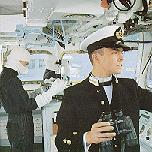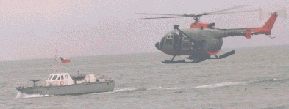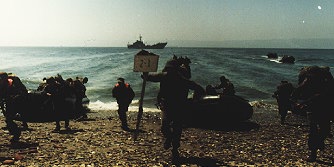Revised: February 1, 1999
Copyright © 1997-1999 by Juan Carlos Barroux R.

![]()


The Navy has a strong and old "blue navy" tradition modeled after the British Navy. During Chilean history the Navy has played an important role and, in part thanks to the geography, has built a strong Naval tradition and history. From the independence wars up to the two wars against Perú and Bolivia through the civil war of 1891 the Navy not only has always emerged victorious but reinforced. During those wars the effective control of sea allowed the Chilean forces to exercise the traditional naval advantage of applying force on land where and when it was most suitable.
Due to the limited economic ressources the Chilean Navy equipment is somewhat old but kept very clean and in good working order. Most important, the crew usually knows how to use it well thanks to its strong professionalisation ratio.

Today's strategic thinking by the Chilean Navy is centered around the concept of Mar Presencial which is the piece of sea where Chile has to have an effective presence. By effective presence it is at least meant patrol and surveillance but ideally should be able to perform sea denial to any other foreign power. To that effect a considerable effort has been undertaken to acquire or built more patrol and sea denial assets. The Taitao project of which 6 examples were built by ASMAR and the acquisition of important aircraft patrol assets in the form of P-3s and O-2s is a clear example of the patrol and surveillance side of this policy. The purchase of a number of missile boats and submarines is part of the sea denial strategy.
The Mar Presencial strategy represents a departure from the traditional rivalry with Argentina and a refocus on the Pacific ocean which has and will have deep impact on future Chilean policy. In particular all sorts of patrol assets and OPVs have been put into service and more could be expected to follow suite.

An important effort is also being made in the area of submarines which is a force considered understrength. The two Type 209 are quite good but limited in range and blue water operations, which is a mayor issue with the Chilean geography. On the other side the two Oberons are showing their age even thought they have beneficed from an extensive mid-life update and probably use their remaining dives with care until the next generation submarines (Scorpène) enters service.
The decision to buy two brand new French/Spanish Scorpène caused some stir inside the institution as the ties with the German manufacturers are very good, specially in ASMAR. Nonetheless this is a clear indication of the will to acquire the latest technology and to go back to the traditional policy of buying brand new ships and boats. One should expect ASMAR to perform the mid-life update of these boats with the probable introduction of an AIP module (MESMA). Also, since the Navy believes that the ideal size of the submarine fleet is between seven to nine boats and given the stated submarine building ambitions it would not be surprising to see ASMAR building a batch of two to four of these submarines.
Today the Chilean Navy faces both the issue of block obsolescence of its main combatants and of their limited remaining hull life. The fleet only has eight mayor combatants, four modified County class and four modified Leander class. This is the lowest numerical strength since the late 30s. Even worst, the average hull age far exceeds 35 years and the engineering challenges to keep the machinery working are stiff. These ships are reported not to be even close of their maximum theorical speeds.

The debate is centered around the option of building locally the replacement ships or to take advantage of the current bargains on the international market, specially the British offer. This conflicts with the stated goal of building the next main combatants locally. An eight frigates building plan has been talked about by ASMAR and the Navy but, in the light of the Asian crisis and its impact on the Chilean economy, this may be an expensive luxury. A compromise solution around a small batch of locally built frigates and some second hand ships (Type 42, Vittorio Veneto, etc.) could be found and would at least partially satisfy everybody. In the meantime, ASMAR has signed a MoU with Fincantieri of Italy covering operation and technical assistance for the design and construction of a new class of frigates. The design of this class is not yet finished but it is understood that the ASTER 15 would be part of the SAAM local air defense system. Recently the Chilean Navy made a call to the other Navies of the region to develop and build this new class of frigates together in what might become the first interamerican design and production of a warship.
The main advantages of the Chilean Navy are the strong professionalism of the force, its "blue navy" traditions and the ability to locally manufacture and/or refit most of its ships, specially in the areas of electronic systems.

The drawbacks are numerous thought. Limited ressources implies that the Navy has now to face block obsolescence of its main combatants, perform with a third of the required submarines, possess inadequate landing ships and no fast jet strike squadron. Even more, the inexistence of any MCM assets indicates a deep lack of understanding of the mining war issues. And, last but not least, the Navy must rebuild its relationship with the civilian part of the country which came under considerable strain during the military dictatorship of General Augusto Pinochet. In particular the use of some naval assets, such as the Esmeralda, as floating jails has tainted its history.
![]()
|
Surface Combatants Patrol Amphibious Auxiliaries |
Submarines Mine and Countermeasures Training Ships Aircrafts Marines |
![]()
![]()
![]()
![]()
This page hosted by
![]() Get your own Free Home Page
Get your own Free Home Page
Copyright © 1997-1999 by Juan Carlos Barroux R.
Juan Carlos Barroux R. - lamilitary@oocities.com